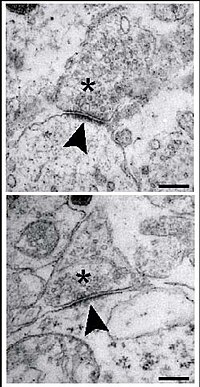Postsynaptic density

Okay kiddo, let's talk about the postsynaptic density. You know that our brains have different parts that help us think and feel, right? But did you know that when we are thinking, it's because of tiny connections between our brain cells called neurons? When one neuron wants to talk to another, it sends a message across a tiny gap called a synapse.
Now, the postsynaptic density is like a fancy reception area at a party where the important guests (neurotransmitter receptors) can come and meet with the host (the receiving end of the synapse- the dendritic spine). The postsynaptic density is a small structure that is found on the receiving end of the synapse- a part of a neuron called the dendritic spine.
It is shaped like a little mushroom with a bulb-shaped head and a thin stem that connects to the receiving neuron. It's called the 'density' because it is jam-packed with lots of different kinds of tiny proteins, each one playing a different role in the brain.
When a message is sent across the synapse, molecules called neurotransmitters float over the gap and land on the head of these little mushrooms. These molecules then interact with the proteins at the postsynaptic density, setting in motion an electrical signal that then passes through the neuron.
This little structure is incredibly important because it helps to regulate the strength of the connection between two neurons. If a connection is used a lot, the postsynaptic density will increase in size and number, allowing the neurons to communicate more efficiently. If a connection is used less frequently, the postsynaptic density will decrease in size and number, making it more difficult for the neurons to communicate.
So, in summary, the postsynaptic density is like a fancy party reception area where the important guests (neurotransmitter receptors) can come and meet with the host (the dendritic spine) to help regulate how well the neurons communicate with each other.
Now, the postsynaptic density is like a fancy reception area at a party where the important guests (neurotransmitter receptors) can come and meet with the host (the receiving end of the synapse- the dendritic spine). The postsynaptic density is a small structure that is found on the receiving end of the synapse- a part of a neuron called the dendritic spine.
It is shaped like a little mushroom with a bulb-shaped head and a thin stem that connects to the receiving neuron. It's called the 'density' because it is jam-packed with lots of different kinds of tiny proteins, each one playing a different role in the brain.
When a message is sent across the synapse, molecules called neurotransmitters float over the gap and land on the head of these little mushrooms. These molecules then interact with the proteins at the postsynaptic density, setting in motion an electrical signal that then passes through the neuron.
This little structure is incredibly important because it helps to regulate the strength of the connection between two neurons. If a connection is used a lot, the postsynaptic density will increase in size and number, allowing the neurons to communicate more efficiently. If a connection is used less frequently, the postsynaptic density will decrease in size and number, making it more difficult for the neurons to communicate.
So, in summary, the postsynaptic density is like a fancy party reception area where the important guests (neurotransmitter receptors) can come and meet with the host (the dendritic spine) to help regulate how well the neurons communicate with each other.
